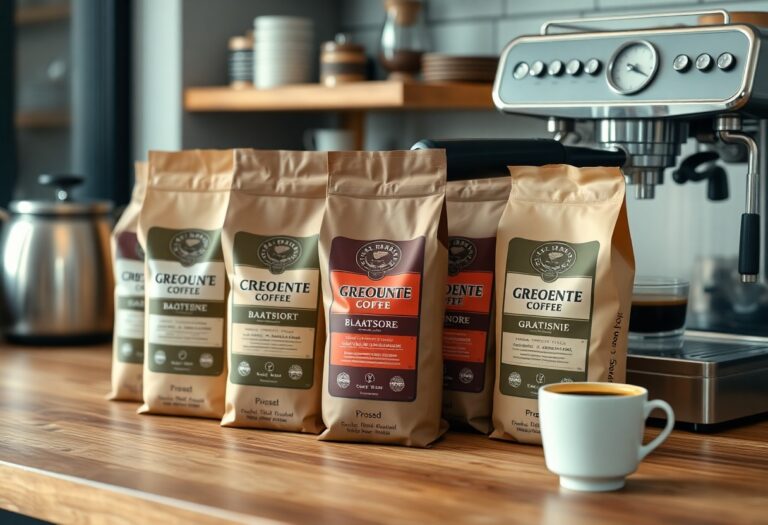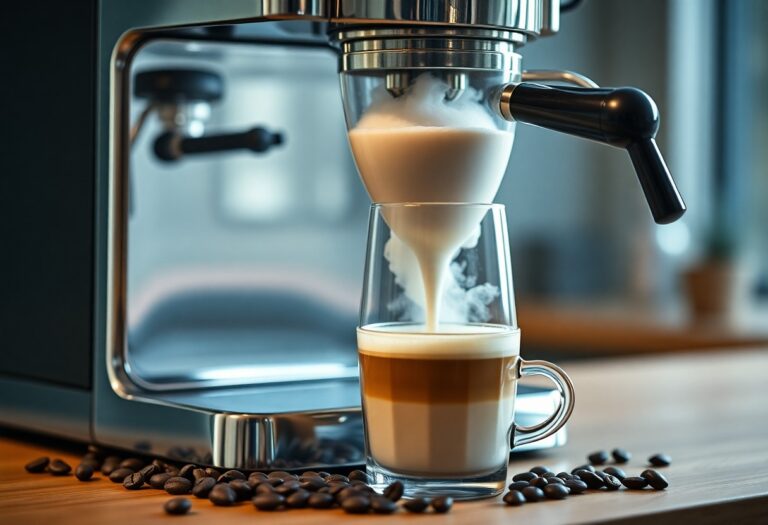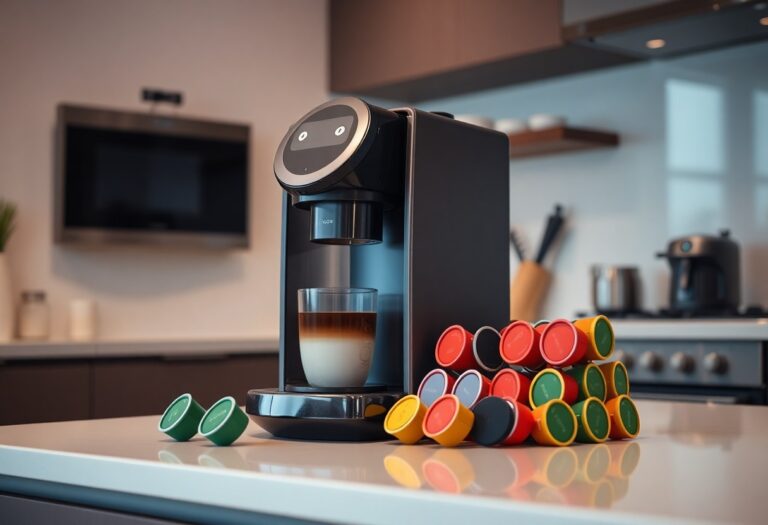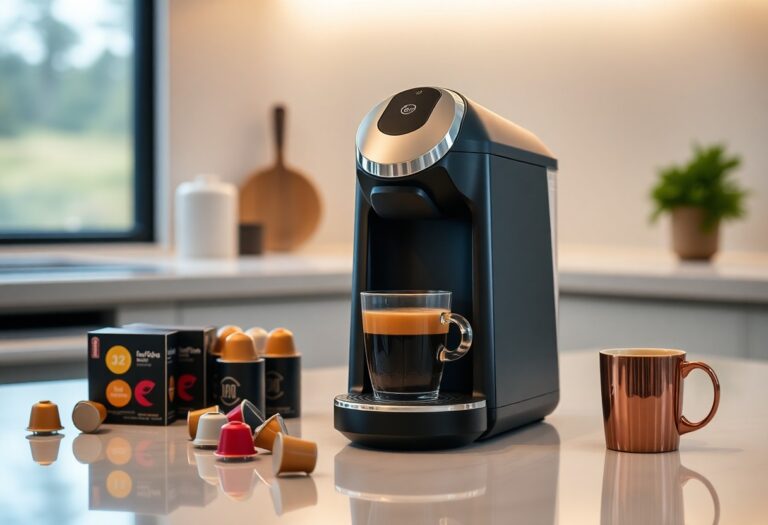What Coffee to Use for DeLonghi Espresso Machine – Brand Guide
Most coffee enthusiasts recognize that selecting the right beans can dramatically enhance your espresso experience. Your DeLonghi espresso machine deserves the best, and using the correct coffee brand not only elevates flavor but also ensures consistency and reliability in your brews. This guide will walk you through key factors to consider when choosing your beans, so you can avoid common pitfalls and enjoy rich, aromatic espresso. For personalization tips, check out this resource on How do I know what dose, grind or temperature to use for … your favorite coffee.

Key Takeaways:
- Select coffee beans that are specifically roasted for espresso to achieve the best flavor profile.
- Freshly ground coffee produces a superior extraction, enhancing the overall taste of your espresso.
- Medium to dark roasts are ideal for espresso machines, as they provide a rich and robust flavor.
- Consider the grind size; a fine grind is important for optimal extraction in a DeLonghi espresso machine.
- Experiment with different brands and blends to find the perfect match for your personal taste preferences.
Unlocking Espresso Brilliance: The Best Coffee Beans for DeLonghi Machines
To achieve espresso brilliance with your DeLonghi machine, you’ll want to explore a variety of coffee beans that create that perfect extraction. Opt for coffee specifically labeled for espresso, as it combines optimal roasting levels with rich flavor profiles that enhance your brewing experience. Look for beans that feature a blend of acidity, sweetness, and body, as these characteristics can make a noticeable impact on your shot of espresso.
Single-Origin vs. Blends: What’s the Difference?
Single-origin coffee beans come from a specific region, providing unique flavor characteristics reflective of their geographical source. They often boast distinctive tasting notes, ranging from fruitiness to earthiness. In contrast, blends combine beans from various origins, allowing roasters to achieve a balanced flavor profile that harmonizes different attributes. While single-origin options can offer a unique taste adventure, blends are designed to create consistency and complexity in every cup.
Flavor Profiles That Elevate Your Cup
Flavor profiles play a vital role in elevating your espresso experience, influencing everything from aroma to aftertaste. Beans with notes of chocolate and caramel can add sweetness, while those with hints of citrus and berry provide zing and brightness. A full-bodied espresso can come from choices like Brazil or Colombia, whereas beans from Ethiopia might surprise you with floral and fruity notes. Your choice greatly affects how balanced or bold your espresso will be.
Exploring various flavor profiles not only enriches your espresso but can also transform your entire coffee routine. For instance, if you prefer a well-balanced cup, you might enjoy a blend featuring Indonesian and Brazilian beans, which can offer a smooth, rich taste. Alternatively, to wake up your senses, selecting an Ethiopian Yirgacheffe can yield vibrant floral notes and a lively acidity. Understanding these flavor profiles allows you to tailor your espresso to suit your palate, ensuring each shot delivers a delightful experience.
The Roast Roast-ing Debate: Light, Medium, or Dark?
Every roast level offers its own distinct flavor profile and aroma, dramatically influencing your espresso experience. Light roasts tend to highlight the beans’ natural acidity and fruitiness, while medium roasts strike a balance between acidity and sweetness, making them a popular choice for a well-rounded flavor. Dark roasts, on the other hand, dominate the palate with bold, rich, and sometimes bitter notes. Choosing the right roast for your DeLonghi espresso machine depends largely on your preferred taste experience and the brewing method.
How Roast Levels Affect Extraction and Taste
Roast levels significantly impact extraction rates and overall taste. Light roasts often require a finer grind, leading to quick extraction, while medium roasts offer a more balanced grind and infusion time, yielding a harmonious blend of flavors. Dark roasts, with their dense structure, may require coarser grinds to prevent over-extraction, resulting in the bitter notes that can dominate the shot if not carefully managed. Understanding how these nuances affect your espresso can help you fine-tune your brewing process for optimal results.
Recommendations for Each Roast Type
For light roasts, consider options like Ethiopian or Panamanian beans that showcase bright, fruity notes. Medium roasts, such as Guatemala or Colombia, are versatile and work well for a balanced espresso. Dark roasts, like Italian or French blends, deliver strong, deep flavors for those who enjoy robust coffee. Each type offers unique taste experiences, inviting exploration for your DeLonghi espresso machine.
When choosing your coffee, think about your personal preferences and the characteristics you enjoy. For instance, if you love a lively, fruity cup, a light roast from Ethiopia might be your go-to. If you appreciate nuances but also want some sweetness, try a medium roast like Colombian. Those who crave intensity and depth will likely favor a dark roast blend. It’s all about experimenting and finding what makes your espresso truly exceptional.
The Impact of Grind Size on Espresso Extraction
Grind size plays a significant role in the extraction process of espresso, affecting flavor, aroma, and crema. A proper grind ensures that water flows through the coffee evenly, extracting the right compounds for a balanced shot. Too coarse, and your espresso may taste weak and under-extracted; too fine, and it could be bitter and over-extracted. Understanding how grind size interacts with your DeLonghi machine is vital for crafting the perfect cup.
Finding the Perfect Grind for Your DeLonghi Machine
Your DeLonghi machine functions optimally with a fine grind, akin to granulated sugar. Experimenting with settings on your coffee grinder can help you find the ideal consistency. A good starting point is to aim for a grind that allows the water to pass through at a pace between 25 to 30 seconds for a double shot. Test and adjust until you discover what works best for your blend and taste preferences.
Common Grinding Mistakes and How to Avoid Them
Avoiding common grinding mistakes is vital for espresso perfection. One prevalent error is using a blade grinder, which often produces uneven sizes. Instead, opt for a burr grinder for a consistent grind. Additionally, neglecting to adjust the grind for different coffee beans or humidity levels can lead to inconsistent shots. Regularly testing your grind and experimenting with settings will help ensure flavorful and aromatic espresso.
Many enthusiasts overlook the importance of grind size consistency. Using a blade grinder might seem convenient, but it can yield a mix of fine particles and larger chunks, resulting in uneven extraction. This can produce a blend of bitter and sour flavors in your espresso, undermining your efforts to create a well-balanced shot. Always invest in a burr grinder, as it allows control over the grind texture. Another frequent mistake involves neglecting the freshness of your coffee; freshly ground beans yield superior flavor compared to pre-ground options. Be diligent about calibrating your grind for different coffee types, and remember to adjust based on environmental factors, such as humidity, which can affect how your coffee beans release oils and compounds.
Brewing Techniques That Make the Most of Your Coffee
Perfecting your brew involves understanding various techniques that enhance the flavor profile of your coffee. From water temperature to tamping down the grounds, each step plays a pivotal role in extracting the ideal aroma and taste from your chosen beans. Master these methods to elevate your espresso experience with your DeLonghi machine and enjoy a rich, barista-quality cup at home.
Water Temperature and Its Role in Flavor Extraction
The ideal water temperature for brewing espresso is typically between 195°F and 205°F. Water below this range may under-extract flavors, leading to a sour taste, while water above can scorch the coffee, imparting bitterness. Experiment with both end ranges to find the temperature that works best for your coffee brand.
Water Temperature Guidelines
| Temperature Range | Effect on Flavor |
|---|---|
| Below 195°F | Under-extraction, resulting in sour flavor |
| 195°F – 205°F | Optimal extraction for balanced taste |
| Above 205°F | Over-extraction, leading to bitterness |
The Importance of Tamping: An Art and a Science
Tamping might seem straightforward, but the technique behind it is both an art form and a precise science. Achieving the right pressure while tamping your coffee grounds is necessary for a consistent extraction, as this step compacts the coffee evenly within the portafilter. A standard guide is to apply about 30 pounds of pressure as you press down.
When tamping, consistency is the name of the game. Applying uneven pressure results in channeling, where water flows through the coffee at different rates, leading to uneven extraction. Precision and technique can be mastered through practice; ensure that you tamp down in a straight, level manner. A solid, even bed of coffee grounds will not only improve extraction but also enhance the overall complexity of your espresso, allowing the rich flavors to shine through in your brews. Aim for a tidy surface, as this will contribute to a better crema on top of your espresso, epitomizing the quality of your cup.

Environmental Factors: Sourcing and Sustainability
Sourcing coffee ethically not only influences the quality in your cup but also impacts the environment and farming communities. As consumers, you hold powerful sway in supporting brands that prioritize sustainable practices. Choose brands that demonstrate commitment to responsible sourcing by engaging in direct trade, investing in local economies, or adopting organic farming techniques.
- Quality is often a direct result of ethical sourcing.
- Look for certifications like Fair Trade or Rainforest Alliance.
- Support brands that invest in environmental sustainability.
Assume that your coffee consumption can drive positive change through your purchasing choices.
Why Sourcing Matters in Coffee Quality
The journey of coffee from farm to cup is complex, and each step significantly influences the final taste and aroma. Beans grown under ideal conditions, often in specific regions known for their unique profiles, yield higher-quality coffee. Sourcing methods that prioritize direct trade provide farmers with fair prices, encouraging them to invest in better farming practices. This relationship not only enhances the beans’ flavor but also contributes to sustainable agricultural practices, ensuring a rich coffee experience while supporting the planet.
Brands Leading the Way in Sustainable Practices
Several coffee brands have established themselves as leaders in sustainability through innovative practices and ethical sourcing. Notably, brands like Intelligentsia, Blue Bottle Coffee, and Stumptown focus on direct partnerships with farmers, emphasizing transparency and quality throughout the supply chain. These brands frequently engage in initiatives to reduce carbon footprints, such as investing in eco-friendly packaging and promoting reforestation projects.
Additionally, brands committed to sustainability often implement programs to help farmers adapt to climate change, thereby ensuring the long-term viability of coffee production. Through initiatives such as farmer cooperatives and educational grants, they empower growers to improve quality and yield sustainably. Supporting these brands not only enhances your espresso experience but aligns your coffee habits with ethical consumption practices that contribute positively to the global coffee community.
To wrap up
Following this guide, you can confidently choose the right coffee for your DeLonghi espresso machine. Opt for high-quality beans that suit your taste preferences, whether it’s a medium roast for balance or a dark roast for bold flavor. Experiment with different grind sizes and blends to discover your perfect cup. By selecting the right coffee, you’ll enhance the espresso experience and enjoy rich, flavorful shots every time you brew. Happy brewing!
FAQ
Q: What type of coffee should I use in my DeLonghi espresso machine?
A: For optimal results, it is recommended to use freshly roasted coffee beans that are specifically labeled for espresso. These beans are typically a blend or single origin with a medium to dark roast profile, providing rich flavors and a good crema. Look for beans with a grind size suitable for espresso, which is usually fine.
Q: Can I use pre-ground coffee in my DeLonghi espresso machine?
A: Yes, you can use pre-ground coffee, but it is imperative to choose a high-quality espresso grind. However, freshly ground coffee is preferred as it releases more aromas and flavors. If you opt for pre-ground, ensure it’s packaged recently and stored properly to maintain freshness.
Q: Are there specific brands known for their compatibility with DeLonghi espresso machines?
A: Many brands produce excellent coffee suitable for DeLonghi espresso machines. Some popular choices include Lavazza, Illy, and Peet’s Coffee. Specialty coffee brands focus on espresso blends, offering unique flavors that can elevate your espresso experience. Experimenting with different brands may help you find your personal favorite.
Q: How does the roast level of coffee affect the flavor in my espresso?
A: The roast level significantly influences the flavor profile of your espresso. Medium roasts typically provide a balanced taste with a mix of acidity and sweetness, while dark roasts yield a bolder, richer flavor with notes of chocolate and caramel. Your personal preference will guide which roast level suits your palate best.
Q: Should I consider using coffee pods with my DeLonghi espresso machine?
A: Coffee pods can offer convenience and consistency, especially if you are short on time. However, they may not provide the same depth of flavor as freshly ground coffee. If your DeLonghi model supports pods, you can try them as an alternative for quick brews, but for the best espresso experience, using freshly ground coffee is advisable.






